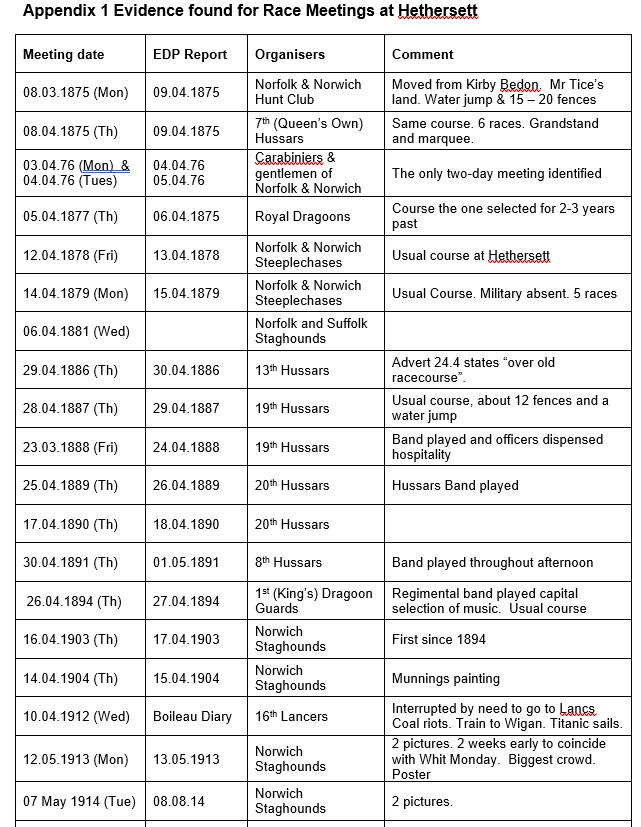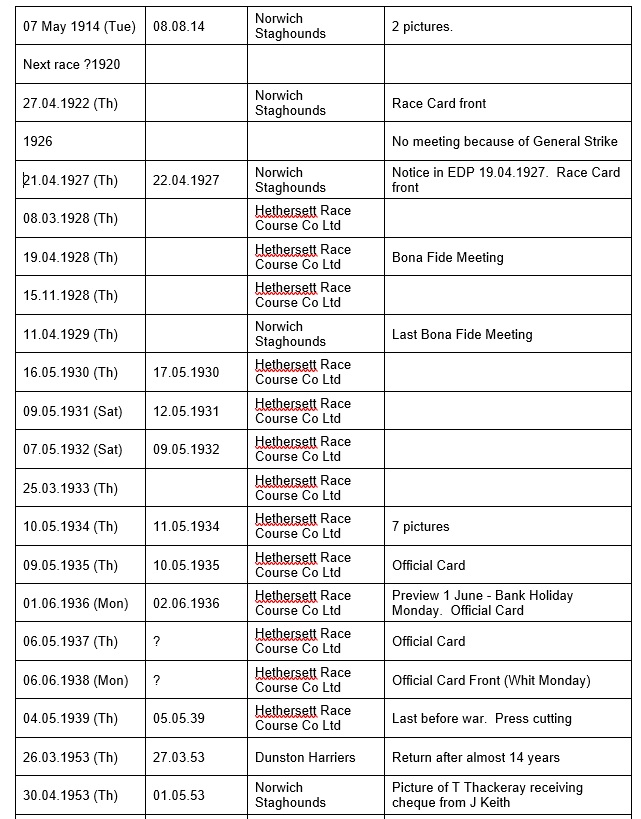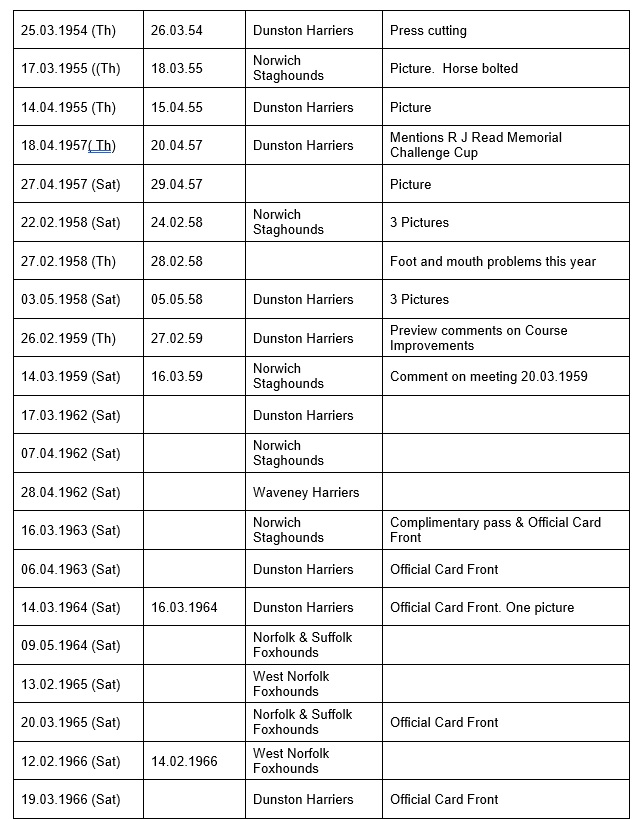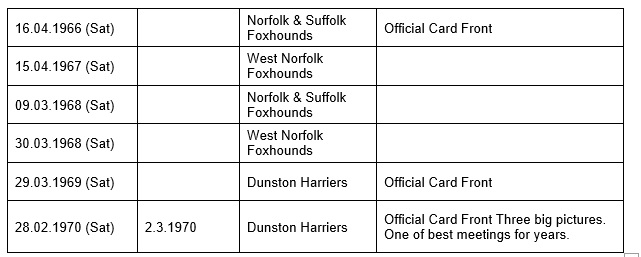I am grateful to Tony & Sue Wright for all of the details shown below.
We became interested in horse racing at Hethersett as we lived at Cantley House, the former farmhouse on Cantley Lane. A prominent landowning family, the Backs of Hethersett, owned the farm from 1818 to 1924 or 1925. Their principle residence was Hethersett Hall. During this time tenant farmers, farm stewards and bailiffs and sometimes up to 3 farm labourers and their families occupied Cantley House. The Back family owned the land over which the races were held. From the front, first floor windows, at Cantley House the occupier would have had a good view of part of the race course. Once or twice a year this quiet backwater must have become a picturesque, lively noisy meeting place for participants and spectators.
Special trains ran from Norwich and Fakenham to Hethersett Station. Morning trains from London also stopped at Hethersett Station on race days. In the 1920’s Newmarket Road trams ran within walking distance of the course (quite a walk by today’s standards). In the early days the race meetings were organised by various Cavalry Regiments stationed at Norwich barracks. The Eastern Daily Press (EDP) reported that on several occasions the Regimental band played and the officers dispensed hospitality. Race days must have been colourful and exciting and a welcome change for the inhabitants of this rural location.
The Cavalry Barracks in Norwich were constructed in 1791 and in the following years were occupied by a variety of regiments. It is believed that the regiments ran the Norfolk and Norwich Staghounds into the 20th Century.
It has not been possible to determine precisely when the races at Hethersett began. The first report found during research in the Eastern Daily Press was on 9 March 1875, referring to the previous day’s meeting organised by the Norfolk and Norwich Hunt Club. A second meeting on 8 April was organised by the 7th Hussars. The EDP began in 1870, its predecessor being the Norfolk Chronicle. No evidence of meetings was found in a quick search between 1870 and 1874 and two random searches of the Norfolk Chronicle of 1865 and 1869 produced nothing. An extract from “A Long Time Gone” by Chris Pitt (2006) has several inaccuracies including a starting date in the late 1880’s.
The Course
It is also not possible to determine an accurate layout of the racecourse or racecourses. In 1886 an advert for the races in the EDP stated “over old Racecourse” which implies that there was more than one, although they all seem to take place over Mr Back’s land. In the early days the course was mostly grass with a little plough. The approximate layout of the racecourse in “A Long Time Gone” appears too small. The A11 is marked to the south of the course. It is almost certain that the A11 dual carriageway (1987) traverses the course. The EDP reported in 1927 that Hethersett was picturesque and one of the prettiest courses. In “the Continuing story of Point to Point Racing” Michael Williams wrote, “It is a long left-handed undulating course with inviting fences and an uphill finish. The viewing is reasonably good provided that one is prepared to move about.”
The course after World War II differed from the pre-war courses as it ran parallel to the railway line. The only map found to date with any reference to the race course is one with Ireland’s Sale particulars for Cantley House and Farm in 1980. Hurdles are marked beside the railway line (see map). This has been reinforced by jockeys’ memories of the course in the 1950s and 60s but with a correction that they are called fences and not hurdles.
The Grandstand
The grandstand is mentioned in reports of the 1875 races and is marked on maps of 1882 and 1890. It was probably of wooden construction and in 1876 Mr Rogers constructed a “commodious grandstand.” The races ceased in 1894 and resumed in 1903 (reason not known). Perhaps very few Cavalrymen were garrisoned at Norwich during this time. Many Cavalrymen fought in the Boer War (1899 – 1902). In 1903 it was reported that Mr Taylor of Cringleford erected the stand and other items. How long did the grandstand last? There was no grandstand after World War II.
Bona fide hunt meetings were introduced in 1912 and bona fide military meetings in 1927. These were little more than glorified point-to-points, although in the case of the military fixtures the courses were often semi-permanent ones. The main difference between bona fide meetings and point to point meetings was that the latter only charged for wagon or car parking whereas bona fide meetings were held over an enclosed course and the public had to pay an entry fee. Bona fide meetings were few and far between.
There is a postcard of Jimmy Lee’s hoarding at the Old Buckenham end of Station Road, Attleborough, in 1913 with a poster advertising Hethersett Races.
Before WWII races at Hethersett were run under National Hunt Rules and afterwards under Point-to-Point rules.
A well-documented event took place in 1914 with Mr Bentfield Hucks flying at Hethersett on May 14, 15 and 16. He took off from the Race course and did aerobatic displays including looping the loop. A newspaper advertised this event and subsequently published a picture and article. A souvenir postcard was also published.
The races resumed after the war in 1920 and continued until 1939. 1926 was the only year without racing due to the General Strike. In 1924 or 1925 Mr Back sold Cantley House and Farm to Mr Horace Ketteringham. In 1927 Mr Robert J Read purchased the area where the races were held (about 120 acres) from Mr Ketteringham. This was to secure the site permanently as the Hethersett Race Course Company Ltd was being incorporated
There is no documentation about the Company except for a share certificate. Enquiries at Companies House revealed that it was incorporated in 1927, Company Number 225385, and that it was subsequently dissolved, the records being destroyed in 1963. It was incorporated again in 1937, Company Number 337865, but dissolved again and the records subsequently destroyed. Presumably the Company still owned the racecourse in 1937. When did this land pass into the ownership of the Thickthorn Estate?
Probably the first meeting to be held in Hethersett was organised by the Norfolk and Norwich Hunt on Monday 8th March 1875. It was on land owned by Mr Tice, situated between the railway line and Thiickthorne House, owned at the time by Mr F E Watson, the course being described as tolerably stiff with 16 fences, 3 flights of hurdles and a water jump.
Monday 8th March 1875
Farmers Stakes over 2 ½ miles
- Prince Plausible (5/4 fav) owned by Mr J Abel and ridden by Mr Michael
- Camel (2/1) owned by Mr T Everitt and ridden by Mr H Brooks
- Lace (3/1) owned by Mr R Bygott and ridden by Mr McVicar
Open Hunters Stakes over 3 miles
- Scarborough Lucy (1/3 fav) owned by Mrs Williams and ridden by Mr A Dobbs
- Aiken Kent (2/1) owned and ridden by Mr W Hope Johnstone
Selling Steeplechase over 2 ½ miles
- Rattlesnake (5/4) owned by Mr Nicholson and ridden by Mr McVicar
- Oakley (4/6 fav) owned by Mr Barclay and ridden by Mr W Hope Johnstone
- Master McGrath (20/1) owned by Mr Tice and ridden by Mr Wickham
Military Plate over 2 miles)
(Officers quartered in the Eastern District)
- Matador (3/1) owned and ridden by Captain Shuttleworth
- Please Do (5/1) owned by Captain Peel and ridden by Mr W B Morris
- Enigma (5/1) owned and ridden by Mr E Atherley
Eastern Counties Hunt Cup over 3 miles
- The Shah (3/1) owned and ridden by Mr R Barclay
- Prince Plausible (2/1 fav) owned by Mr J Abel and ridden by Mr Michael
- Camel (6/1) owned by Mr T Everitt and ridden by Mr H Brooks
The meeting at Hethersett on Thursday 8th April 1875 was organised by the Queen’s Own Hussars and followed just one month after the successful meeting held on the same course in March which was administered by the Norfolk and Norwich Hunt.
Thursday 8th April 1875
Subalterns Challenge Cup over 2 miles
(presented by Captain Joy)
- Meredith (5/1) owned and ridden by Mr T G Smith
- Burlesque (3/1) owned and ridden by Mr W Hope Johnstone
- The Weasel (4/5 fav) owned and ridden by Lord M Beresford
Regimental Challenge Cup over 3 miles
(presented by Sir Lydston Newman)
- Jack Frost (4/1) owned and ridden by Honorable E Jervis
- Starlight (10/1) owned and ridden by Mr W Hope Johnstone
- Matador (6/4 fav) owned and ridden by Captain F Shuttleworth
Drag-Hunt Steeplechase over 3 miles
- Camperdown (6/4 fav) owned by Mr J Abel and ridden by Lord M Beresford
- Evergreen (5/1) woned and ridden by Mr P Hudson
- White Sleeve (6/1) owned by Mr Tice and ridden by Tunnally
Weltee Challenge Cup over 3 miles
(presented by Captain J L Hunt)
- Matador (4/6 fav) owned by Captain F Shuttleworth and ridden by Mr W H Johnstone
- Nutmeg (10/1) owned by Mr J H Phipps and ridden by Mr W B Morris
- Tim (10/1) owned and ridden by Mr E Roper
Hussar Challenge Cup over 2 miles
(presented by Colonel Trevelyan)
- Jack Frost (3/1) owned and ridden by Honorable E Jervis
- Pateb (6/1) owned and ridden by Honorable A Byng
- The Changeling (6/1) owned by Captain J L Hunt and ridden by Mr W B Morris
Consolation Plate over 2 miles
- My Lady (evens fav) owned and ridden by Mr W Hope Johnstone
- The Weasel (5/2) owned and ridden by Lord M Beresford
- Cruikshank (3/1) owned by Captain J L Hunt and ridden by Mr W B Morris
Pre-WWII Memories.
Local people have reported that:-
Some went by pony and trap, the entrance to the course being from Station Lane along the track at the side of the bungalow 1 Station Lane. Jack Bloom is particularly remembered riding “Tonderman”. Aubrey Cook at Station Farm stabled some of the horses - the cattle sheds may have been used as stables.
During World War II the course was used to train people to fly gliders. Mr Duncan Pigg of Hethersett trained on Dagling gliders – primitive craft open to the elements. The gliders were launched by winch, the glider staying attached until the pilot was proficient. When proficient he let go of the winch and glided down on his own.
There was racing at Kirby Bedon after the war but racing at Hethersett did not resume until 1953 with a meeting organised by Norwich Staghounds. Dunston Harriers organised the 1954 races. These two hunts organised all the races until 1962. A second meeting in 1962 was run by the Waveney Harriers.
In January 1964 the Norwich Staghounds became the Norfolk and Suffolk Foxhounds but this hunt failed in 1968 due to insufficient foxes and objections from the Easton, and Waveney, Harriers. They organised meetings in 1964, 65, 66 and 68. West Norfolk Foxhounds met at Hethersett between 1965 and 1968 with five-card events. In 1969 and 1970 the meetings were organised by the Dunston Harriers. All meetings between 1963 and 1970 were held on Saturday afternoons.
Post-WWII Memories
Local people have reported that:-
The entrance was the same as before but some spectators entered the racecourse via the grounds of Thickthorn Hall. The course was 1½ miles long and ridden twice. There were 8 jumps and the first fence was jumped three times making 17 jumps in all.
The last passenger train at Hethersett station was on 29 January 1966. This must have had a considerable effect on race goers without cars but no doubt there was a bus service to Station Lane, Hethersett.
The last Hethersett races were in 1970.
“It ceased to be a racecourse in 1970 because the costs of running the races were very considerable. The estate had always borne a large proportion of these and the Hunts were unable to make any contribution as costs rose and attendances fell. They felt they could make more money by holding their meetings elsewhere.” (Quoted from a letter from Mr Charles Watt, grandson of the first Viscount Mackintosh.)
This was confirmed by Mr Stanley Ward who was manager in 1970. The animals had to be moved and the area prepared for racing and this involved most of the farm workers. The many vehicles driven over the land on race days churned up the grass which took quite a while to recover.
Appendix 1 Evidence found for Race Meetings at Hethersett




NB:
- This list may be incomplete. Searching microfilm reels at the Norfolk Heritage Centre was not the most exciting pastime.
- 1865 The Norfolk Hunt (16th Lancers) meeting held at Trowse 25 April.
- 1871 Sole Norfolk Steeplechase at Kirby Bedon (14 April).
Appendix 2. From the Norwich Mercury April 5 1876
MILITARY AND NORFOLK AND NORWICH STEEPLECHASES.
STEWARDS FOR MILITARY STEEPLECHASES.
Colonel Napier (Carabiniers)
Captain C. F. Marriott
Captain H. Burnley
Captain C. H. Williamson
Captain Hon. J. D. Drummond
STEWARDS FOR NORFOLK AND NORWICH STEEPLECHASES.
Sir E. H. K. Lacon, Bart., M.P.
Lord Marcus Beresford
S. Grimmer, Esq.
J. Lee Barber, Esq.
C. Chaston, Esq.
These races were commenced on Monday at Hethersett and everything tended to make the first day a success. The charming piece of country placed at the disposal of the committee, an exceptionally fine day, with the promise of good sport – and the racing on Monday was in every instance earnest and spirited - drew together an innumerable throng of people. On either side of the portion of the course staked out were long lines of vehicles, of all descriptions, from the imposing drag of the well-to-do, to the pony cart of the costermonger. Of course there were the usual inevitables of a race course present. The bookmakers were warned "by order” that betting would not be allowed in the paddock, but a great number of them nevertheless established themselves in that enclosure; their incessant pleadings with the public to accept their “ten to one on the field," showed business must have too slow with them. Disputes of course occurred between these people and their clients, and then it was a matter of who could roar the loudest.
The prevailing propensity seemed to have been the desire to impose on the unwary: the pipe-light vendor induced a bargain by offering three boxes of his warranted “flamers” and retained one of them; the nut seller deceived by skillfully manipulating his paper of nuts; and the cake man took the money and returned nothing for it. And this passion even seemed to have extended to the authorities at the gate, where the prices for admission fluctuated from a shilling to two pence, the order seemingly having been "Get it where you can."
We were grieved to be a witness of a scene of rowdyism that occurred during the day. The occasion for the irritation of the crowd seemed to have been the striking of a lad who was running the gauntlet up the course, by one of those on horseback in charge of the course. An opportunity was soon found to retaliate, and the boy, who had gathered together a large number of his companions, chiefly from the rough element, made an attempt to pull the horseman from his horse. Of course the police thereupon interfered, and they fared somewhat badly in the hands of the crowd: one had his eye blackened, and another had the tail of his coat torn. However, the affair seemed to have ended, and things appeared to be working smoothly again, when a crowd for some indefinable reason gathered at the back of the stand, where Mr. Paynton Piggott, the Deputy Chief-Constable of the county, from some vantage post, was observed to be offering counsel to the crowd to disperse themselves. Immediately a detachment of the Carabiniers were ordered to charge the crowd, and accordingly the charge was made, the people being scattered and trampled about in the most violent manner; and again returning, they galloped through the throng ere they had recovered from their surprise. This proceeding effectually put an end to the scene.
We cannot understand the statement made, apparently upon authority, "That all vehicles are admitted on the ground free of charge," as we noticed in several instances that payment was demanded and made. Otherwise everything worked well, punctuality being observed in getting off the races, and fit and proper accommodation having been made for the public. A very substantial stand was erected on the ground, by Mr. Rogers, of Norwich.
Appendix 3 The Gurney Family and Thickthorn.
Richard Hanbury Gurney (1783 – 1855) bought Thickthorn Hall in 1830 and it remained in the family’s ownership until 1930 when it was bought by Alan Rees Colman, a director of the family firm of J. J. Colman, and a Norwich magistrate.
Francis Hay Gurney (perhaps a nephew of Richard Hanbury) had a longstanding interest in hunting and died at Thickthorn in 1890 at the age of 65. His son, Edward Hay Gurney, born in 1866, was a lifelong huntsman starting with the Shotesham Harriers and soon moved on to the West Norfolk Foxhounds and Norwich Staghounds. He left Thickthorn in 1904 to live in Ipswich.
Much of the information about this course has been found using internet research and is in the public domain. However, useful research sources have been:-
London Illustrated News
Racing Illustrated 1895-1899
The Sporting & Dramatic Illustrated
Northern Turf History Volumes 1-4 by J.Fairfax-Blakeborough
The Sporting Magazine
A Long Time Gone by Chris Pitt first published in 1996 ISBN 0 900599 89 8
Racing Calendars which were first published in 1727



